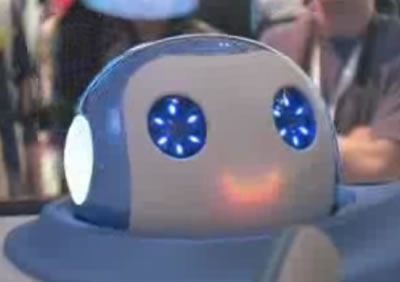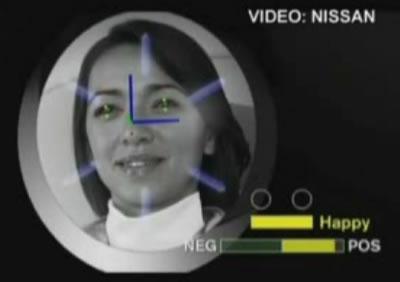Science Fiction
Dictionary
A B C D E F G H I J K L M N O P Q R S T U V W X Y Z
Mood Recognition Technology: Pivo 2 Driver Experience Enhanced

Mood recognition technology plays an important part of the Pivo 2 concept car from Nissan, now being shown at the 2007 Tokyo Motor Show. Pivo 2 has an in-dash robot (a "robotic agent") to enhance the driver's connection with the car; the intent is that the driver will see the car as a "creature, rather than as a machine."

(Pivo 2 in-dash robot)
According to Masato Inoue, Nissan's chief designer, the Pivo 2 concept car's robot can reduce accidents by engaging the driver and making sure that the driver is not too tired or inattentive. "When drivers are happy, the accident rate is drastically lower," he observes. "The robot agent is there to cheer up the driver, to guide the driver and to sense the sleepiness of the driver."
(Masato Inoue, Nissan's chief designer: Pivo 2 video)
One essential element of Pivo 2's mood recognition technology is the camera mounted in front of the driver. The camera monitors the driver's eye movement to determine if the driver is becoming sleepy. Pivo 2 can tighten the seat belt to try to snap the driver out of it.
Pivo 2 can also judge from the driver's face whether the driver is happy or sad.
The Pivo 2 in-dash robot chats cheerfully with the driver, offering information at the request of the driver. "Where is the parking lot?" she asks. "One hundred meters on the right," says Pivo 2, looking forward and to the driver's right. "And two hundred meters to the left," says Pivo 2, swiveling to the left. "The one on the left is cheaper."
The Pivo 2 robot, according to Inoue, sometimes "guides the driver, and sometimes cheers up the driver." It may say "you look angry - please calm down."
Current mood recognition technology is not quite good enough to enable science fictional ideas like Frank Herbert's daily schedule from his 1977 book The Dosadi Experiment, which could determine the mood of its user and respond appropriately:
"Good morning, ser," it fluted.
McKie, who could interpret the analysis of his mood from the DS tone, put down a flash of resentment. Of course he felt angry and concerned.
"Good morning, you dumb inanimate object," he growled...
Hopefully, Nissan's designers also take into account the rapidly changing moods of human beings.
Other real-world attempts at mood recognition:

(Pivo 2 determines the driver's mood)
(Pivo 2 robot chats with the driver in video)
The Daily Schedule began playing to McKie as he emerged from the bath. The DS suited its tone to his movements and the combined analysis of his psychophysical condition.
Read more about the Nissan Pivo 2 Concept Car.
RoomRender also is able to respond to the mood of users. The unique FeelingWall has colored lights that change according to the mood of the people in the room.
Kanei looks through its database of more than 500,000 words and then correlates them with basic emotions, like happiness and sadness.
Scroll down for more stories in the same category. (Story submitted 10/29/2007)
Follow this kind of news @Technovelgy.| Email | RSS | Blog It | Stumble | del.icio.us | Digg | Reddit |
Would
you like to contribute a story tip?
It's easy:
Get the URL of the story, and the related sf author, and add
it here.
Comment/Join discussion ( 0 )
Related News Stories - (" Engineering ")
Secret Kill Switch Found In Yutong Buses
'The car faltered as the external command came to brake...' - Keith Laumer, 1965.
The Desert Ship Sailed In Imagination
'Across the ancient sea floor a dozen tall, blue-sailed Martian sand ships floated, like blue smoke.' - Ray Bradbury, 1950.
The Zapata Air Scooter Would Be Great In A Science Fiction Story
'Betty's slapdash style.'
Could Crystal Batteries Generate Power For Centuries?
'Power could be compressed thus into an inch-square cube of what looked like blue-white ice' - Edmond Hamilton, 1940.
Technovelgy (that's tech-novel-gee!) is devoted to the creative science inventions and ideas of sf authors. Look for the Invention Category that interests you, the Glossary, the Invention Timeline, or see what's New.
Science Fiction
Timeline
1600-1899
1900-1939
1940's 1950's
1960's 1970's
1980's 1990's
2000's 2010's
Current News
Bone-Building Drug Evenity Approved
'Compounds devised by the biochemists for the rapid building of bone...'
Secret Kill Switch Found In Yutong Buses
'The car faltered as the external command came to brake...'
Inmotion Electric Unicycle In Combat
'It is about the size and shape of a kitchen stool, gyro-stabilized...'
Grok Scores Best In Psychological Tests
'Try to find out how he ticks...'
PaXini Supersensitive Robot Fingers
'My fingers are not that sensitive...'
Congress Considers Automatic Emergency Braking, One Hundred Years Too Late
'The greatest problem of all was the elimination of the human element of braking together with its inevitable time lag.'
The Desert Ship Sailed In Imagination
'Across the ancient sea floor a dozen tall, blue-sailed Martian sand ships floated, like blue smoke.'
The Zapata Air Scooter Would Be Great In A Science Fiction Story
'Betty's slapdash style.'
Thermostabilized Wet Meat Product (NASA Prototype)
There are no orbiting Michelin stars. Yet.
Could Crystal Batteries Generate Power For Centuries?
'Power could be compressed thus into an inch-square cube of what looked like blue-white ice'
India Ponders Always-On Smartphone Location Tracking
'It is necessary... for your own protection.'
Amazon Will Send You Heinlein's Knockdown Cabin
'It's so light that you can set it up in five minutes by yourself...'
Is It Time To Forbid Human Driving?
'Heavy penalties... were to be applied to any one found driving manually-controlled machines.'
Replace The Smartphone With A Connected Edge Node For AI Inference
'Buy a Little Dingbat... electropen, wrist watch, pocketphone, pocket radio, billfold ... all in one.'
Artificial Skin For Robots Is Coming Right Along
'... an elastic, tinted material that had all the feel and appearance of human flesh and epidermis.'
Robot Guard Dog On Duty
I might also be thinking of K-9 from Doctor Who.
